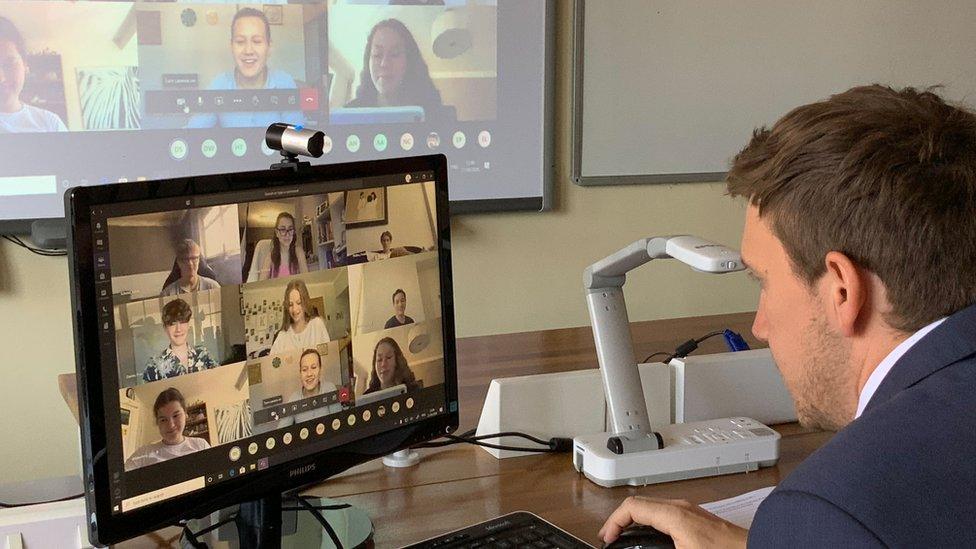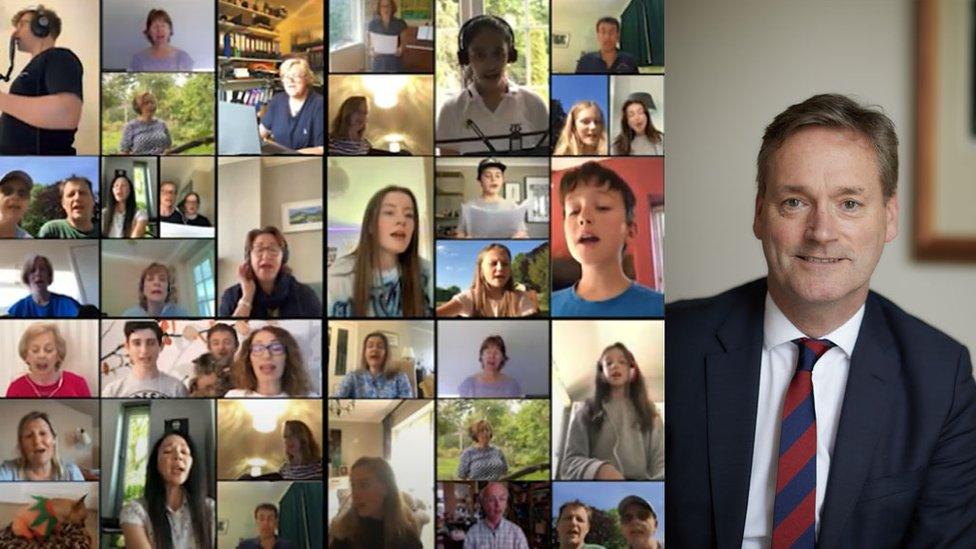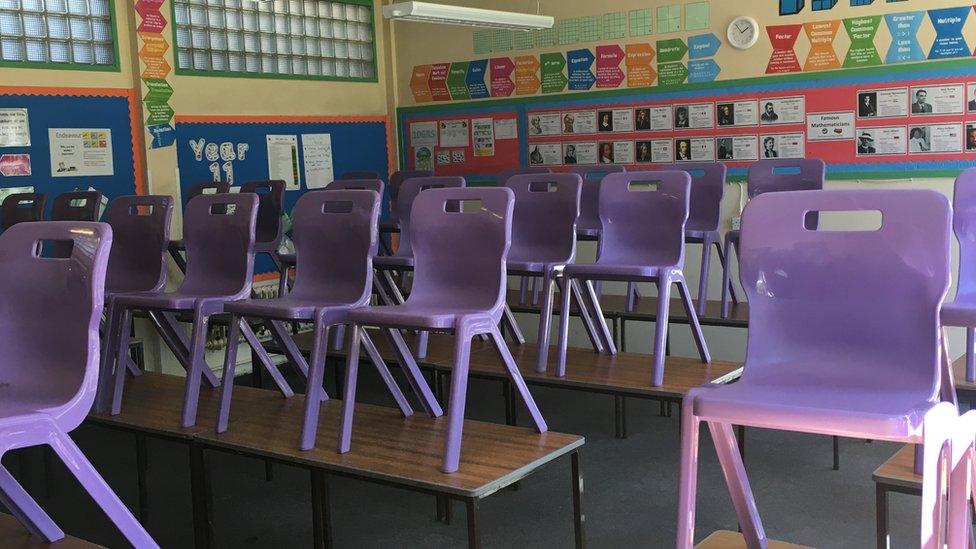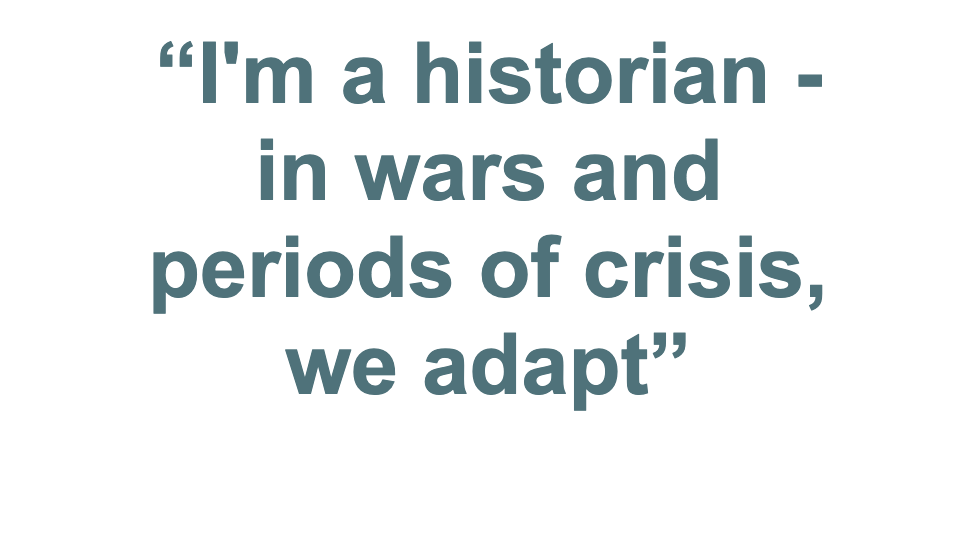Home schooling: The Zoom haves and have nots
- Published
- comments

Future in full flow: Teacher and students at Epsom College
Throughout James Malley's usually bustling school, classrooms sit strangely empty and quiet. Chairs sit neatly on top of tables after the cleaners have been through. But sitting at his head teacher's desk, he can see and hear students chatting from far away, as he watches the potential future of education in a coronavirus world.
Sixth form geography students are mid-video conference. Their teacher, working from home, is talking about volcanoes - transmitting a presentation direct into their homes - just as if it were on the whiteboard in the classroom.
"When we closed down, I don't think anybody was even contemplating no GCSEs, no A-Levels schools and not coming back for the rest of the academic year," he says.
So sitting staring at a virtual class is not how Mr Malley set out to lead Therfield School in Leatherhead, Surrey - nor did any other head teacher anywhere else in the world.
But if social distancing continues until who-knows-when, he and thousands of other heads know that video classes may now be inevitable. And that, in turn, is developing into an enormous existential dilemma for his profession: will teachers unintentionally, deepen the education divide between "Zoom Haves" and "Zoom Have Nots"?

James Malley: Multi-tasking budgets, teachers' contracts and watching a live video class pilot
Since the UK's national closure of schools began in March, many heads like Mr Malley have taken their schools through three broad phases of completely reinventing the way they teach:
Emergency packs to maintain the learning habit in the first weeks
More comprehensive materials delivered online for all subjects
Grander plans if schools are going to find it impossible to fully reopen
"We're not trying to replicate the school day," says Mr Malley. "In any given two weeks there is a core offer and then other activities to extend the curriculum."
Therfield is now fully embedded in the second of these three phases. Teachers have converted their classroom materials into Powerpoint-style presentations that are delivered via the homework portal. They call each student, every week, for a chat - and they can see proof of actual progress through formal online assessments.
But it's in phase three that the risks really begin to emerge, say many teachers. If schools try to recreate live online classes, will the poorest students lose out?
First mover advantage?
Epsom College is a grand private school, close to the world famous race course and five miles from Therfield. Almost half of its pupils are boarders, many of them children from abroad whose families value a traditional English education. Like Therfield, headmaster Jay Piggot and his leadership team rapidly developed a stop-gap plan of online worksheets, to keep teaching going during the first weeks of lockdown.

Jay Piggot: Video has helped keep the community together - including with a virtual choir
And like many other independent schools, they've moved far more quickly to full video classes - and are now offering all their students a broadcast curriculum, throughout the day. They are using Microsoft Teams, rather than Zoom. Other providers are available. The school day has been shortened - and classes only run for 40 minutes. And there are more breaks to help teachers prepare and give everyone a screen break. His staff and students have already learnt a lot.
"You have to concentrate much harder within a video conference - you won't get the body language cues," says Mr Piggot. "Teaching tends to be more of a monologue and then a response. But there are strengths too. If a teacher sets a question and the students can respond online, then the teacher has received an immediate insight. That is very useful, but in terms of the richness of the classroom, it's no comparison."

Not the classroom of the future - everyone hopes
The technology has also helped, virtually at least, preserve the school community as video has brought pupils together for assemblies, challenges and even a digital choir, external.
So, is there now a coronavirus technological divide widening the gap between independent and state schools?
Jay Piggot says he is concerned there will be - and he's sharing what he has learnt so far about video teaching with the state schools near to him.

What works for remote learning?
Teaching quality is more important than how lessons are delivered
Ensuring access to technology is key, especially for disadvantaged pupils
Peer interactions can provide motivation and improve learning outcomes
Supporting pupils to work independently can improve learning outcomes
Different approaches to remote learning suit different types of content and pupils

And Stephen Fraser of the Education Endowment Foundation, a leading education charity, says there is now a historic challenge.
"Universal and compulsory schooling are the great leveller," he says. "This crisis has thrown that universal platform in the air. There is now a huge variability in what students can access."
The EEF predicts that the most disadvantaged students may need 12 months or longer to catch up on what they have lost during lockdown. But he adds: "Teaching practice always trumps the platform. Whether it's video conferencing, through to the delivery of hard [paper] copies of lessons, if it is backed up by high quality teaching, that is what matters."
"We know that if a teacher makes a phone call at the start of the week to the child who they know, that can be really effective."

Instinctively, state school heads like Mr Malley are restless to do more. That's where the dilemma of embracing video classes will become acute. Some 15% of Therfield students are eligible for free school meals - the national average. Approximately 10% of the 910 students are what Mr Malley terms internet poor - either they have no proper access at all, or it is limited by availability of devices or bandwidth in the home.
"We've got parents working from home and they have one laptop between them. If we say at 10 o'clock, it's your history lesson, that's not meaningful. If you think about schools in more deprived areas, you're going to be doubling those figures.
"So you are then into a situation where you have to ask how much are those students losing out compared to their peers?
"That is the moral dilemma that state school heads are facing," says Mr Malley. "Every time we decide to do more, there might be some students who won't get access."
The Department for Education has already launched a major programme to lend laptops and other technology to disadvantaged families. But while James Malley welcomes the government cash - it remains an imperfect solution to what could become, for some, a perfect storm of underachievement because of factors beyond sending data across the internet.
"I'm a historian by trade. In wars and in periods of crisis, we adapt. We will probably end up doing some things better than we have ever done them. But that's not a replacement for the things that you lose."

SCHOOLS: When will children be returning?
THE R NUMBER: What it means and why it matters
LOOK-UP TOOL: How many cases in your area?
